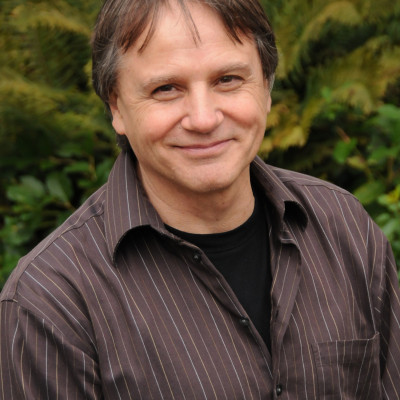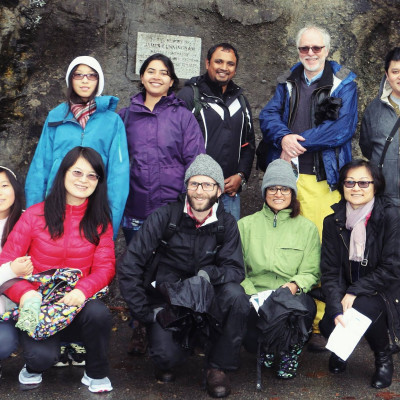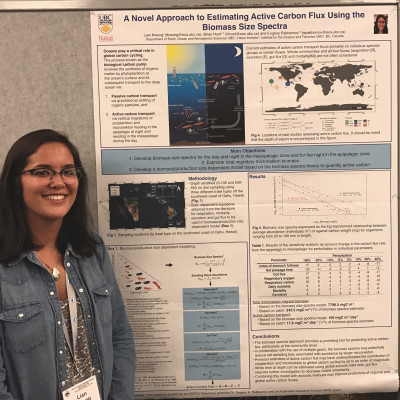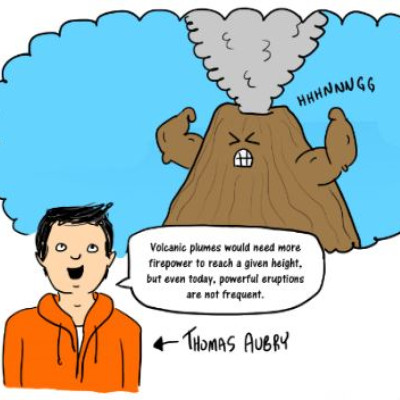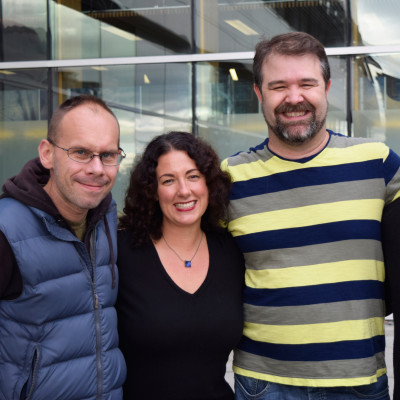News
Stay up-to-date with what's happening in EOAS
Curtis Suttle Elected ASLO Sustaining Fellow
Congratulations to Professor Curtis Suttle, who was elected a Sustaining Fellow in the Association of the Sciences of Limnology and Oceanography (ASLO). This honour recognizes ASLO members who have advanced the aquatic sciences via their exceptional contributions to the benefit of the society and its publications, meetings, and other activities. The 2016 ASLO Fellows will be honored at the ASLO Meeting in Honolulu in February 2017.
Read more about this award and the ALSO Fellows: http://aslo.org/announce/fellows2016.html.
Paul Smith leads MOSAIC Earth History tour of Stanley Park
Despite hideous weather, a hardy group showed up to take part in a field trip to Stanley Park run by Paul Smith entitled The forces that shape British Columbia: fire, ice and earthquakes, as part of the MOSAIC BC program. MOSAIC helps new immigrants and refugees to Greater Vancouver learn about the culture and physical environment of their new surroundings.
The focus of the excursion was the sea walk from Prospect Point to Siwash Rock looking at the cliffs and the beaches. The field trip participants examined Cretaceous-Eocene sedimentary rocks intruded by a 33 million year old dike. The view of the North Shore through the mist and rain clouds provided an opportunity to talk about geologic uplift and its relation to local subduction and earthquakes. The granite boulders scattered on the seashore originating from the Coast Mountains brought on discussion of the force and extent of glaciers once present in Vancouver. An illustrated handout and geologic glossary helped participants engage with what they saw during the tip.
Paul expects that trips like these with MOSAIC will become an annual event. More MOSAIC events including field trips can be found on their events calendar and Facebook page.
MSc student wins best poster at oceanography conference
Congratulations to MSc student Lian Kwong on winning Best Biological Oceanography Poster at the 2016 PICES Annual Meeting in San Diego, California.
Lian's poster entitled A Novel Approach to Estimating Active Carbon Flux Using the Biomass Size Spectra detailed her work on modelling the contribution of micronekton, the size classification of marine organisms between 2 – 10 cm, in transporting carbon vertically in the water column. Micronekton migrate to water near the ocean's surface during the day to feed on plankton, then return deeper to the mesopelagic zone at night. Natural processes including respiration, excretion, and death of the micronekton produces a net flux of carbon from the surface to the deeper ocean.
Prior attempts at modelling the contribution of various organisms' behaviour to this "active carbon pump" considered only the contribution of individual species or the flux resulting from particular processes. Lian instead quantifies the change in carbon flux of organisms in bulk by modelling metabolic processes according to organism size distribution. Depth stratified trawls from the waters off the southwest Coast of Oahu in 2004 provided Lian with a starting point of the quantity of organisms of different size fractions present. From there, Lian was able to model the quantity of carbon transported based on equations postulated within the literature dependent on organism size. The result is an all-inclusive picture of carbon transport to the deep ocean, and the surprise that previous estimates of carbon flux for may have underestimated the transport of carbon by zooplankton and micronekton by an order of magnitude. Combined with acoustic methods to more efficiently determine the regional size distribution and quantity of organisms present, Lian's model could provide enhanced predications of regional and global active carbon fluxes.
Lian is supervised by Professor Evgeny Pakhomov, who was recently appointed Director of the UBC Institute for the Oceans and Fisheries.
Climate change may prevent cooling by volcanic eruptions
New research by PhD student Thomas Aubry shows that climate change may hamper the ability of large volcanic eruptions to cool down the planet.
Large volcanic eruptions produce plumes containing sulfuric gases that can reach 10 – 15 kilometers high, reaching a layer of Earth's atmosphere known as the stratosphere. There the gases react with water to form aerosols, tiny suspended particles that reflect incident sunlight away from the Earth thereby cooling the planet. Aerosol particles linger in the stratosphere for 1 – 2 years; aerosols that form in the lower level of the atmosphere, the troposhere, are short lived because they are purged by precipitation. Historic large volcanic eruptions have directly coincided with some of the coolest global temperatures in human history, and the rate of global warming has slowed over the last 10 – 15 years in part to volcanically generated sulfuric aerosols.
“Volcanic eruptions tend to counteract global warming. But as the planet warms and our atmosphere changes, we’ve found that less eruptions may reflect back the Sun's radation,” said Thomas “It will be harder for the volcanic gases to reach high enough into atmosphere to help cool the planet.”
Thomas combined a of volcanic plumes with published global climate models to determine their interaction. He discovered that two effects of climate change will raise the bar on the intensity of a volcanic eruption required to for the plume to reach the stratosphere. First, increased carbon dioxide concentrations in the atmosphere increases the density gradient of the atmosphere through which the plume travels, causing the volcanic plume to stabilize and spread at lower altitudes. Second, the volume of the troposphere itself will expand, shifting the troposphere–stratosphere boundary higher. As a result, the average input of sulfuric gas input to the stratosphere is modeled to decrease anywhere from 2 – 12% over the next century, and by as much as 25% within the next two centuries.
Just how those changes will impact Earth's surface temperature is a subject of further study. Thomas' supervisor, Mark Jellinek, notes that this “new positive feedback has provocative implications for understanding climate variability in Earth’s past. In particular, this mechanism may have contributed to Earth’s entry into a protracted global glaciation around 700 Million years ago (Snowball Earth).”
Thomas' results are published today in an article entitled Impact of global warming on the rise of volcanic plumes and implications for future volcanic aerosol forcing in the Journal of Geophysical Research: Atmospheres. Thomas' results were also covered in the American Geophysical Union's blog Geospace, where science writer and artist JoAnna Wendel documented Thomas' research as a colourful comic.
Related Links
Annual EATS and Undergraduate Instructor of the Year Awards
At the annual Welcome Back BBQ, our department recognized the dedication and hard work of deserving administrative staff. This year's recipients of the Excellence in Administrative and Technical Services Awards are Alicia Warkentin, Undergraduate Program Coordinator, and Charles Krzysik, Computer Staff System Analyst.

Alicia Warkentin
Alicia is known to almost everyone in the Department as the ever cheerful and helpful person at the front desk of our main office. Over the past year, without training, she stepped into the role of Undergraduate Program Coordinator where she performed admirably. As her nominator expressed it, “ Alicia has always embraced changes and transformed them into opportunities”.

Charles Krzysik
Charles is a member of the EOAS IT group responsible for maintaining our servers, ensuring security, and modernizing our administrative office support. Over the past year, Charles helped many of our research groups move to secure cloud servers to help automate the sharing of data with collaborators. As one of his numerous nominators said, “I cannot count the number of hours and days of work saved by Charles’s help over the past year”.
Additionally, the department recognized excellence in teaching through the Undergraduate Instructor of the Year Award. This year's recipients are Brett Gilley and Mark Jellinek.

Brett Gilley
Brett is an instructor is known through the department for championing for his progressive approaches to undergraduate education. Students in Brett's courses, EOSC 110 The Solid Earth: A Dynamic Planet and EOSC 114 The Catastrohpic Earth: Natural Disasters appreciate his humor, energy, and care. As one of his EOSC 114 students put it, "Brett is always super enthusiastic and is genuine about what he teaches. He shows interest and true passion about his courses. Brett's positive attitude makes a difference."

Mark Jellinek
Students praised Mark Jellinek's in his instruction of both of EOSC 212 Topics in the Earth and Planetary Sciences and EOSC 453 Physics of the Earth and Other Planets. His frequent use of discussion and challenging level of material inspired students to rise to the occasion. As one student writes on EOSC 453 "Mark was an incredible professor and the style of this class was unlike any other university course that I have taken thus far. He also amazingly somehow brought a class of 55 students that previously did not know each other very well or at all very close."
Professor Kelly Russell elected Fellow of the Mineralogical Society of America
This honor is bestowed every year upon only ~10 scientists worldwide who have contributed significantly to the advancement of mineralogy, crystallography, geochemistry and petrology. Kelly was awarded for “admirably holding the banner of petrological approach to the understanding of the Earth”, for being “a constant force on the Canadian, American and European scene where his name and contributions are recognized by the vast majority of practicing petrologists”, and for “his unique combination of enthusiasm, rigor and selflessness” in science.
